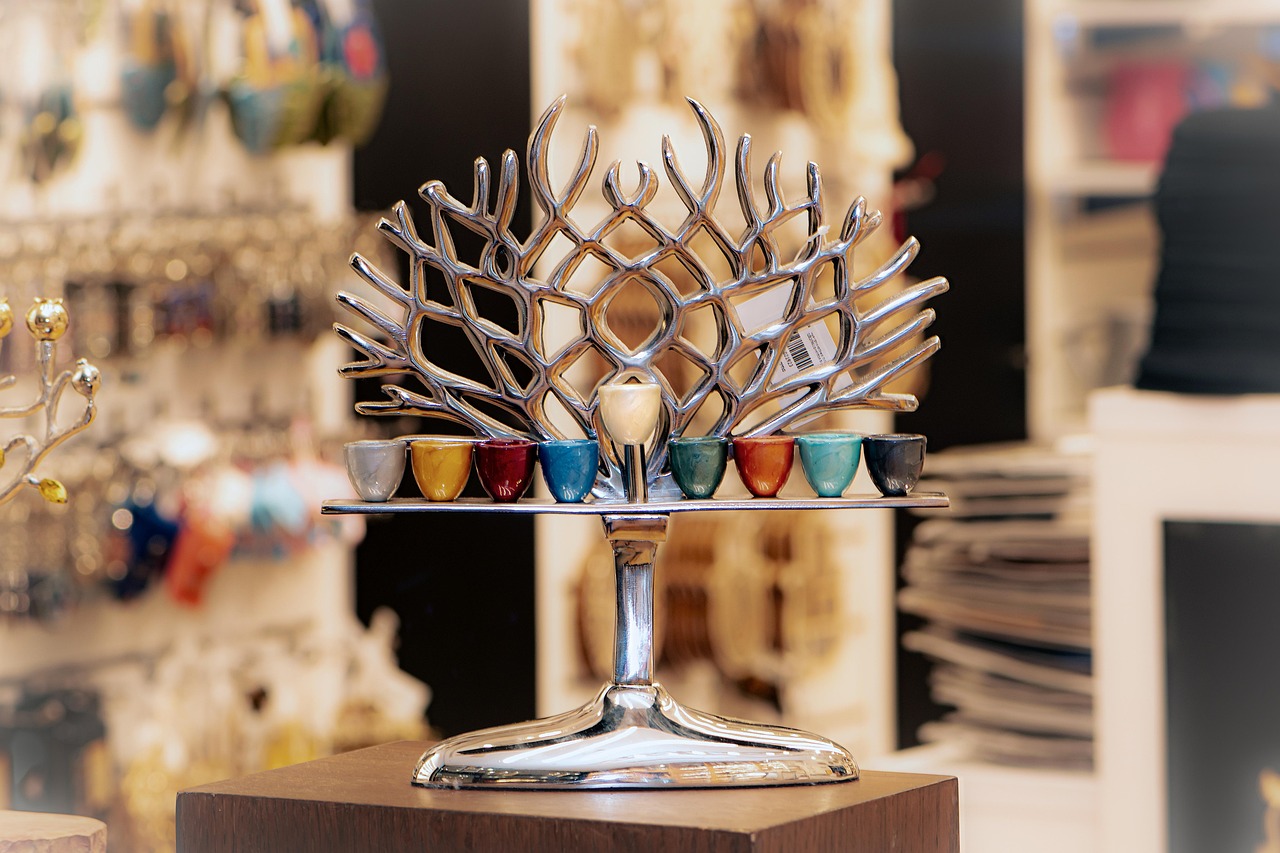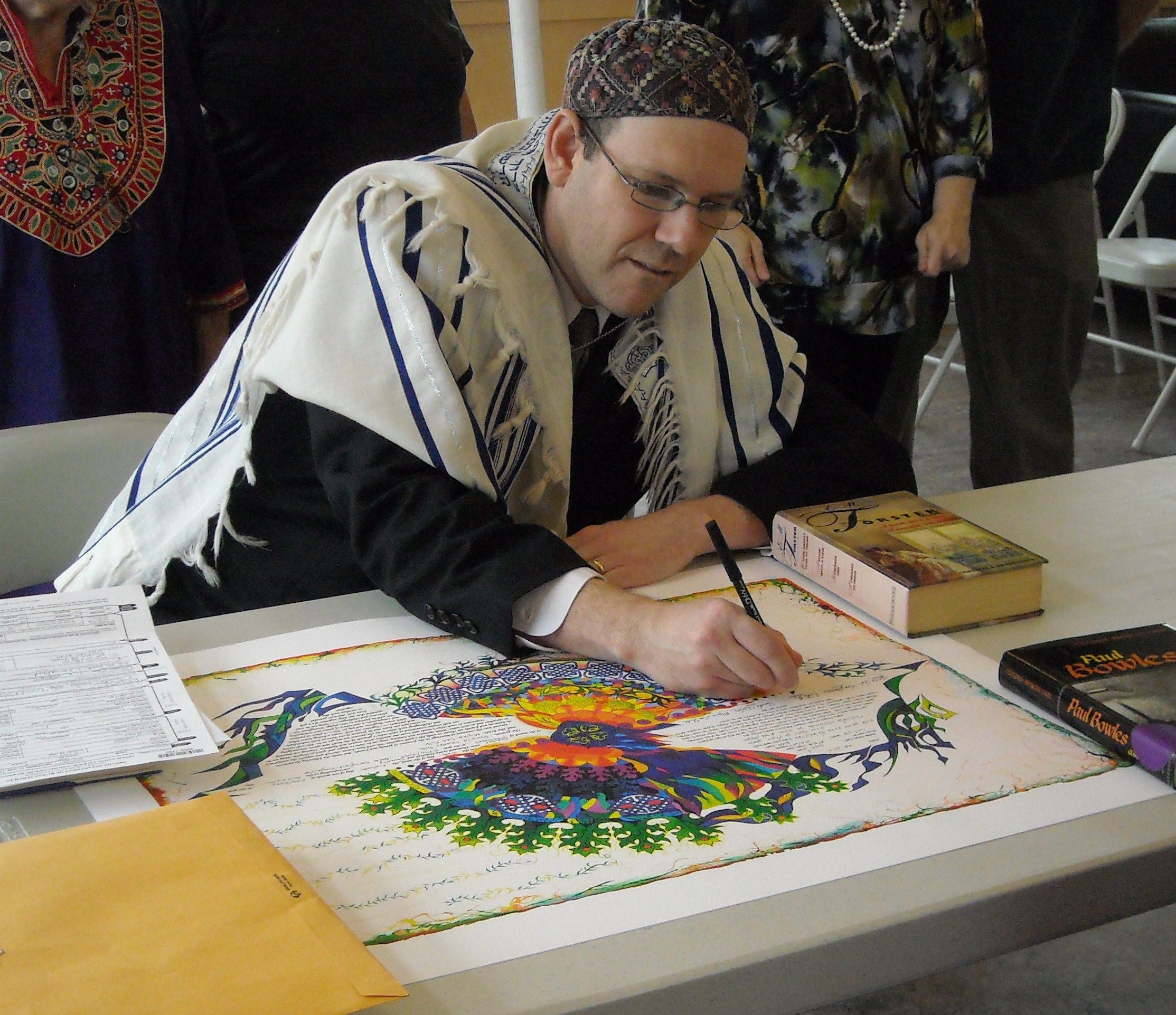I swore unto you, and I entered into a covenant with you, and you became mine.
Psalm 130
In searching for a ceremony to welcome Ayelet into the brit between God and the Jewish people, we looked for texts that included conceptions of brit that weren’t necessarily tied to one gender or another. There are four verses in the Bible which refer to foreskins and to three other symbolic foreskins; the foreskin of the lips, the foreskin of the ears, and finally the foreskin of the heart. The three latter foreskins symbolize the barriers that can block a person from speaking, hearing, and feeling God. The biblical verses referring to foreskinned hearts, ears, and lips are:
All of Israel are of foreskinned hearts. (Jeremiah 9:30)
Whom shall I speak and give testimony, that they may hear? Behold their ears are foreskinned and they cannot listen. (Jeremiah 6:10)
Moses said before God, Behold I am of foreskinned lips, and How will Pharoah listen to them? (Exodus 6:30)
While the foreskin of the penis obviously does not apply to females (although there is a rabbinic position that considers females circumcised 1 , the foreskins of the lips, the ears, and the heart certainly apply to females as much as to males. One might say regarding females that their bodies are already “open” and so do not need to be cut.
Our prayer for Ayelet is that she will be able to enter into a covenant with God, one in which she is not closed off from the divine presence. We pray that she will never lose the openness that she now has. And that she will be able to remove barriers not only between her and God, but between her and others and between her and herself.
The ceremony that we have developed to represent her entrance into brit, is one in which we symbolically remove barriers–barriers which, if not yet present, tend to grow with age. While newborn babies are fresh from God, “trailing clouds of glory”(Wordsworth), barriers, unfortunately, often grow with age.
Welcoming Ayelet into the World
“From the depths I have called to You God. My God (Eli) Hear my voice, hear my voice, hear my pleading.”2
מִמַּעֲמַקִּים קְרָאתִיךָ יָהּ אֵלִי שִׁמְעָהּ בְּקוֹלִי שִׁמְעָהּ בְּקוֹלִי שִׁמְעָהּ תַּחֲנוּנִי
My dove in the clefts of the rocks
In the secret of steep ravines,
Show me your face
Let me hear your voice
For your voice is pleasing,
And your appearance is beautiful.3
יוֹנָתִי בְּחַגְוִי הַסֶּלַע בְּסֵּתֶר הַמַּדְרֵגָה הַרְאִינִי אֶת מַרְאַיִך הַשְׁמִיעִינִי אֶת קוֹלֵךְ כִּי קוֹלֵך עָרֵב וּמַראֵיך נָאוֵה
Yonit b’khagvi hasela b’seter hamadreygah harini et marayikh hashmi’i’ni et kolekh ki arev u’maeykh naey.
Ayelet enters the room and all say:
Brukha Haba’ah! (Blessed is she who enters!)4
בְּרוּכָה הַבָּאָה
One is my dove, my perfect one,
the choice of her who bore her,
women see her and sing of her joy,
queens and brides chant her praise.5
אַחַת הִיא יוֹנָתִי תַּמָּתִי אַחַת הִיא לְאִמָּהּ בָּרָה הִיא לְיוֹלַדְתָּהּ רָאוּהָ בָּנוֹת וַיאַשְׁרוּהָ מַלְכוֹת וּפִילַגְשִׁים וַיהַלְלוּה
Akhat hee yonati tamati akhat hee l’imah barah hee lyoladtah ra’u’hah banot vy’ashruhah malkhat u’filagshim vy’halelu.
Brit: The Covenant Ritual
This is the chair of Elijah!
זֶה כִּסֶה שֶׁל אֵלִיָּהוּ הֲנָבִיא זָכוֹר לַטּוֹב. בָּרוּךְ אַתָּה אֲדֹנָי אֱלֹהֵינוּ מֶלֶךְ הָעוֹלָם אֲשֶׁר קִדְּשָׁנוּ בְּמִצְוֹתָיו וְצִוָּנוּ לְהַכְנִיסָהּ לַבְּרִית שֶׁל אַבְרָהָם אָבִינוּ וְשָׁרָה אִמֵּנוּ
Zeh kiseh shel eliyahu hanavi latov. Barukh atah Adonay eloheynu melekh haolam asher kidshanu b’mitzvotav v’tzivanu l’hakhnisah lab’rit shel Avraham avinu v’Sarah imeynu.
Blessed are You God Ruler of the Universe who has sanctified us with Your commandments and commanded us to bring her into the covenant of Abraham our father and Sarah our mother.
אַמֵּן כְּשֵׁם שֶׁנִּכְנְסָה לַבְּרִית כֵּן תִּכָּנֵס לְתוֹרָהּ וּלְאַהֲבָה לְחֻפָּה וּלְמַעֲשִׂים טוֹבִים
Amen. K’shem shnikhnasa labrit ken tikanes l’torah ul’ahavah l’chuppa ul’ma’asim tovim.
Amen. Just as she is entered into the covenant, so may she be entered into torah, the marriage canopy and good deeds.
We mark6 her heart in hope that her heart will be open to the world and the God behind it.
We mark her ears in hope that she will hear the still small voice of God.
We mark her lips in hope that they will give voice to God’s presence.
God’s words of covenant to a female Israel (Ezekiel 16:6-9)
I have caused to increase like the bud of the field, and you did increase and grow and you did come to excellent beauty, your breasts were formed, and your hair was grown; you were naked and bare.
And I passed over You and saw you, and behold your time was the time of love, and I spread my wings upon you and I covered your nakedness and I swore unto you, and I entered in a covenant with you. And you became mine.
And I passed over you, and I saw you wallowing in your blood, and I said to you: ‘In your blood you shall live. In your blood you shall live.
As she is washed and anointed with oil the following words are recited:
Then I washed you with water, and washed the blood from upon you, and I anointed you with oil.7
Kiddush
This is the cup of Miriam!
זֶה הַכּוֹס שֶׁל מִרְיָם
Zeh hacos shel Mir’yam
Blessed are you God, King of the Universe, who has created the fruit of the vine.
A paragraph of blessing from a Sephardic rite that welcomes a daughter into the covenant:
מִי שֶׁבֵּרַךְ אִמּוֹתֵינוּ שָׂרָהּ וְרִבְקָה רָחֵל וְלֵאָה וּמִרְיָם הַנְּבִיאָה וַאֲבִיגַיִל וְאֶסְתֵּר הַמַּלְכָּה בַּת אֲבִיחַיִל, הוּא יְבָרֵךְ אֶתְ הַיַּלְדָּה הִנְעִימָה הַזֹּאת, וְיִקָּרֵא שְׁמָהּ _________ (פְּלוֹנִית בַּת פְּלוֹנִי וּפְלוֹנִית).
בְּמַזָּל טוֹב וּבִשְׁעַת בְּרָכָה, וִיגַדְּלוּה בִּבְרִיאוּת, שָׁלוֹם וּמְנוּחָה, וִיזַכֶּה אֶת אָבִיהָ וְאֶת אִמָּהּ לִרְאוֹת בְּשִׂמְחָתָהּ וּבְחוּפָּתָה, בְּבָנִים עֹשֶׁר וְכָבוֹד. עוֹד יְנוּבוּן בְּשֵׂיבָה, דְּשֵׁנִים וְרַעֲנַנִים וְכֵן יְהִי רָצוֹן וְעוֹד יְנוּבוּן בְּשֵׂיבָה דְּשֵׁנִים וְרַעֲנַנִים יִהְיוּ וְנֹאמַר אַמֵּן.
Mi Shebeirakh imoteynu imoteynu Sarah, Rivkah, Rachel vLeah uMiryam ha-n’viah v’Avigayil v’Ester ha-malkah bat avikhayil, hu y’varekh et ha-yalda ha-n’ima hazot vayikareh shmah ________bat ___________ b’mazal tov uv’sha’at brakha,v’yigadluha bivriut shalom, menukha. V’y’zakeyh et avihah v’et imah lirot b’simkhatah uv’khuppatah b’vanim osher v’khavod v’od y’nuvun b’sevah d’shenim v’ra’a’nanim v’khen yehi ratzon v’od y’nuvun b’sevah d’shenim v’ra’a’nanim yih’yu v’nomar amen.
1. See Talmud Avodah Zarah 27a.
2. This text recalls Ayelet coming through the birth canal, an event which confers upon her the status of a Jew. The only other way she could become a Jew, according to halakhah is if she had been immersed in the mikveh, an event which also recalls coming out of the womb. See Rabbi Gary Shapiro’s article in Pardes Revisited for a discussion of what he calls Brit Leyda, the Covenant bestowed by birth itself.
3. Song of Songs 2:14. This text recalls our calling her out of the womb so that we could behold her, and hold her.
4. Song of Songs 6:9. This text signifies her arrival into the world.
5. The texts from Song of Songs are part of a Sephardic rite, Zeved Habat, which welcomes a daughter into the world.
6. We use henna to mark her, recalling the blood of the covenant. Henna is traditionally used in a ritual with a Yemenite woman before her wedding ceremony. In a brit ceremony developed by Rabbi Jeremy Schwartz, he uses henna to recall dam brit, the blood of the covenant.
7. We took these verses out of order to fit the context of a brit for a female. Similarly, the Sifre (Rabbinic Midrash) takes them out of order. You can see how the Sifre uses these verses in most traditional editions of the Passover Haggadah.












